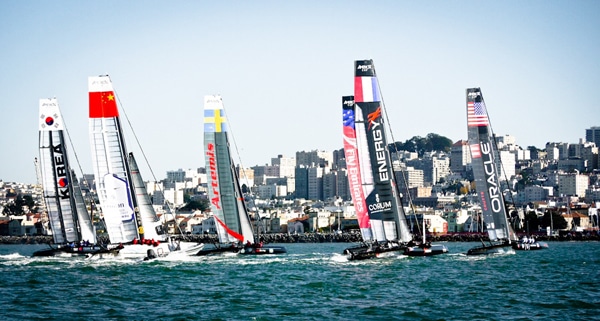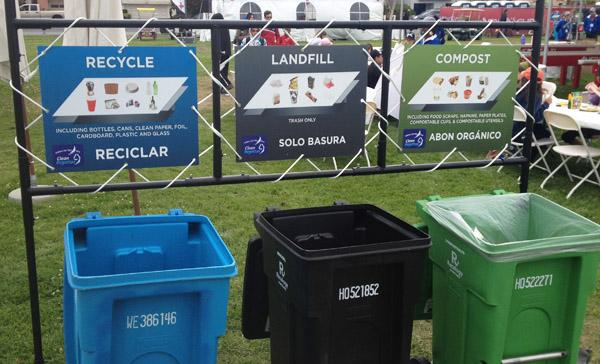
AC45s
For the past 18 months, the team at Sailors for the Sea has been working closely with the America’s Cup Event Authority (ACEA) as the Official Clean Regattas Partner to the 34th America’s Cup. Some may say that composting and copper-free bottom paints are the least exciting part of the Cup, but Sailors for the Sea begs to differ. Have you seen those sexy new waste stations yet? They’ve received a lot of questions about sustainability as it relates to the America’s Cup. With the summer of AC racing fast approaching, it’s a great time to talk more about what exactly SfS’s relationship with the America’s Cup means for you, me, the ACEA, and ocean health in general.
At its most basic, Sailors for the Sea is The Official Clean Regattas Partner of the 34th America’s Cup. They have helped reduce the environmental footprint of all America’s Cup World Series (ACWS) events to date. Their work will continue this spring at the ACWS in Naples, and also this summer at The Louis Vuitton Cup and The 34th America’s Cup in San Francisco.
But what does that mean?
Since August 2011, every ACWS event has received Clean Regattas certification. Sailors for the Sea staff have been on site at each ACWS identifying the achieved Best Practices, recommending where improvements can be made, and documenting the results. This information is then reviewed by an independent panel to determine the final level of certification awarded. The ACEA has worked hard to improve upon each certification with a steady increase in certification level over time.
What does it take to get certified?
Sailors for the Sea and the ACEA have collaborated to develop a stringent checklist that breaks the Best Practices into 67 specific, metric-oriented subsidiary categories. These categories range from requiring only non-toxic cleaning products, to ensuring the containment of maintenance, to outreach on ocean health with spectators. For every category met, a point is assigned that goes into calculating the overall achievement percentage, which translates to the certification award level. This large, data rich spreadsheet is reviewed by experts in varying fields to ensure the future achievement of requirements or necessary changes to establish a higher level of certification at the next events.
Below are highlights of the impressive accomplishments from each ACWS:
- Cascais: Organizers achieved Clean Regattas Bronze level certification with just one month of preparation time.
- Plymouth: Copper-free bottom paint was used on all motor vessels. This is an important improvement in environment practice that is still very uncommon in the United States.
- San Diego: Strict measures established to prevent runoff, not an ounce of water from the dock was allowed to enter the bay.
- Naples: Race Management worked together to beautify the site by removing large trash items on a nearby beach, such as refrigerators and tires, leaving the site much cleaner than when they arrived.
- Venice: Volunteers protected a rare bird species from human traffic by building a nesting enclosure.
- Newport: Conservation activity created a Rain Garden that continues to help prevent run-off year round, leaving a lasting benefit to Narragansett Bay. And this was the first AC event to receive a Gold Clean Regattas certification.
- San Francisco #1: First-ever Platinum level Clean Regatta; 58 of the 67 possible points were achieved.
- San Francisco #2: An impressive 98% of waste at the event did not go into area landfills – a result of extensive recycling and composting efforts.
**

**
If the ACEA already achieved Platinumn, now what?
Sailors for the Sea and the America’s Cup Event Authority have worked tirelessly to achieve this strong success, and when it comes to protecting our environment there is always room for improvement. In fact, the city of San Francisco insists on it. Two key elements of sustainability during the coming summer of America’s Cup racing include a commitment to holding a waste-free event, and achieving carbon neutrality by reducing emissions and purchasing offsets for those that can not be avoided (aka T.V. helicopters).
What can you do?
- If you attend America’s Cup events, become a part of the solution! Bring your reusable water bottle, arrive by public transportation or bike, separate your waste properly, and enjoy the racing!
- Not able to attend? You can bring Clean Regattas to your sailing center or marina. Contact info@sailorsforthesea.org to learn how you can become a Clean Regattas champion.
- Not a racer? Bring green practices to your recreational boat. Personal action makes a big difference
- Educate others about ocean health issues. Share one of Sailors for the Sea’s Ocean Watch Essays.
- Support ocean conservation by making a donation to Sailors for the Sea. 80% of each dollar goes directly to program implementation.









